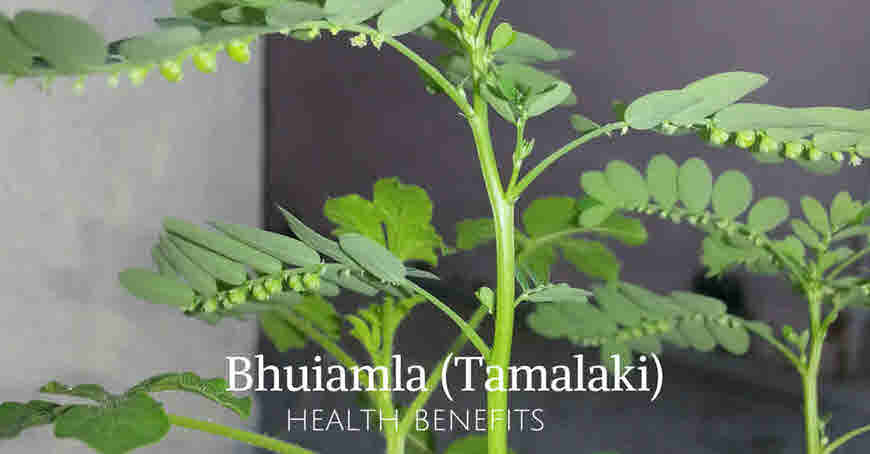Tamalki is used in Ayurveda for the treatment of many diseases especially related to the liver. In Africa, this plant is used by people in the treatment of the kidney stones, dysentery, jaundice, diarrhea, wounds, ulcers and urogenital diseases.

Bhuiamla is a very common broad spectrum magical medicinal herb native to India. It grows as weed throughout the hotter part of country. During rainy season, you can find it growing abundantly in gardens, waste lands, parks, along roadsides, open areas, etc. You can identify this medicinal herb by looking underside of its leaves. There you will notice small round structures which look like amla. There are many Medicinal use of Bhui Amla.
In modern medicine, there is no effective specific therapy is available for viral hepatitis but Tamalki has shown clinical efficacy in viral Hepatitis B.
General Information
- Botanical name: Phyllanthus amarus Schum & Thonn (P. niruri auct. Non L.) P. fraternus Webster
- Family: Euphorbiaceae
- Vernacular names:
- Sanskrit: Bhuamlaki, Bahupatri
- Assamese: Bhuin Amla
- Bengali: Bhumamla, Bhumi amalaki
- English: Country gooseberry
- Gujrati: Bhoi Amali, Bhony amari, Bhonyamali
- Hindi: Jangliamli, Hazardana, Jaramala, Bhui amla
- Kannada: Nelanelli
- Kashmiri: Kath
- Malayalam: Kizanelli, Keezhanelli, Ajjhada
- Marathi: Bhuiawali
- Oriya: Bhuin Amla
- Punjabi: Lodhar
- Tamil: Kizhukai nelli, Kizanelli
- Telugu: Nela usirika
Availability: Annual plant;Grows during rainy season (July to September);under safe conditions, can grow and survive till winters
Distribution of the plant: Tropical and sub- tropical regions of Asia, Africa, and America
Description of the plant
Leaf of the plant
Plant leaves are compound; leaf-let arranged in two rows with a rachis, alternate, opposite and decussate almost sessile, stipulate, oblong, entire; up to 1.5 cm long and 0.5 cm wide; color greenish-brown; odour of leaf is indistinct; taste bitter
Plant Stem
Slender, gabrous, light brown, and cylindrical; length 20-75 cm;branching profuse towards upper region bearing 5-10 pairs of leaves; internode, 1-3.5 cm long;odour indistinct; taste slightly bitter
Root of the plant
Small; length of root 2.5-11 cm; nearly straight, gradually tapering, with a number of fibrous secondary and tertiary roots; external surface light brown, fracture, short
Bhuiamlaki medicinal properties
The Bhuyamla plant is diuretic plant. It has the ability to clear or open the natural ducts of the fluids and secretions of the body. The plant has an astringent properties and causes contraction of the skin cells and body tissues. This plant is used as single drug to treat jaundice. The plant has antiviral activity against hepatitis B virus. It has the liver protecting activities which is supported by lab studies. It effectively repair CCl4 induced the liver damage in rats.
Bhuiamla is also indicated in Gonorrhea, Frequent menstruation, Diabetes, disorders of the skin such as sores, swelling, and itchiness .
Bhui amla Plant has the following medicinal properties
- Lipid Lowering Activity
- Anti-Diabetic Activity
- Anti-Malarial Activity
- Hypotensive and hypoglycaemic activity
- Antiviral activity against hepatitis B virus
- HIV (human immunodeficiency virus) Replication Inhibition effect
- Hepato-protective effect/ the liver protecting
- Analgesic, Antibacterial, Antifungal, Astringent
- Ability to expel and prevent stone formation in the body
The plant exhibits medicinal properties due to the presence of various bioactive substances. The phytochemical analysis of the plant extract has confirmed the presence of tannins, saponins, flavonoids and alkaloids. The plant extract have been found to contain high levels of saponins, tannins, flavonoids and alkaloids. The plant is a very rich in potassium due to which it is powerful diuretic.
For the medicinal purpose whole plant, leaves, and roots are used.
Bhuiamla for the liver Diseases
Bhuiamla is effective medicinal herb for treating the liver diseases including Hepatitis B.
The plant shows marked anti-hepatitis B virus surface antigen activity in in-vivo and in-vitro lab studies.
In a clinical study, 37 patients with chronic viral hepatitis B, were treated with daily dose of 600mg of Bhuiamala for 30 days. 59% of the patients lost the HBsAg two weeks after the end of the treatment. HBsAg is the surface antigen of the hepatitis B virus (HBV). It indicates current hepatitis B infection. From this study, the authors postulated that Phyllanthus niruri might inhibit proliferation of the virus by inhibiting replication of the genetic material of the virus.
Traditional uses of Phyllanthus amarus
Phyllanthus amarus or Bhui amla is used traditionally for treating a variety of diseases. The hot water extract of whole plant on oral intake has fever reducing and laxative effect. The decoction is also useful in the fever reduction. In treatment of jaundice whole plant is dried and pulverised to get powder that is taken with buttermilk. In the case of loose motions, dysentery dried leaves infusion is given. In diabetes, hot water extract is useful. Fresh leaf juice or fresh root juice are taken orally for sexually transmitted disease STDs.
The plant is also used externally. For skin diseases, cuts, bruises the leaves juice is applied topically on the affected part. The fruit is used externally for tubercular ulcers scabies and ringworm.
Is the name of bhuin amla is same of bari amla in odiya language
Odiya name is Bhuin Amla, for bari amla have no clue.